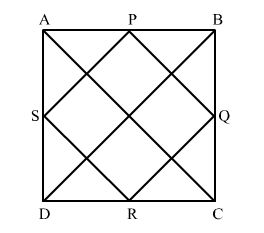The midpoints of the sides AB, BC, CD and DA of a quadrilateral ABCD are joined to form a quadrilateral.
The midpoints of the sides AB, BC, CD and DA of a quadrilateral ABCD are joined to form a quadrilateral. If AC = BD and AC ⊥ BD then prove that the quadrilateral formed is a square.

Given: In quadrilateral ABCD, AC = BD and AC ⊥ BD. P, Q, R and S are the mid-points of AB, BC, CD and AD, respectively.
To prove: PQRS is a square.
Construction: Join AC and BD.
Proof:
In ΔABC,
$\therefore P Q \| A C$ and $P Q=\frac{1}{2} A C$ (Mid-point theorem) ...(1)
Similarly, in ΔACD,
$\therefore S R \| A C$ and $S R=\frac{1}{2} A C$ (Mid-point theorem) ...(2)
From (1) and (2), we get
PQ || SR and PQ = SR
But this a pair of opposite sides of the quadrilateral PQRS.
So, PQRS is parallelogram.
Now, in ΔBCD,
$\therefore Q R \| B D$ and $Q R=\frac{1}{2} B D$ (Mid-point theorem) ...(3)
From (2) and (3), we get
RS || AC and QR || BD
But, AC ⊥ BD (Given)
∴ RS ⊥ QR
But this a pair of adjacent sides of the parallelogram PQRS.
So, PQRS is a rectangle.
Again, AC = BD (Given)
$\Rightarrow \frac{1}{2} A C=\frac{1}{2} B D$
But this a pair of adjacent sides of the rectangle PQRS.
Hence, PQRS is a square.
Click here to get exam-ready with eSaral
For making your preparation journey smoother of JEE, NEET and Class 8 to 10, grab our app now.
